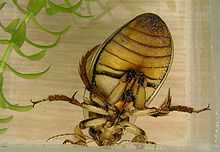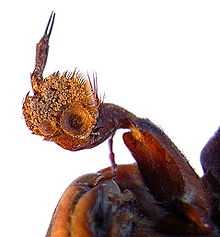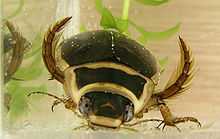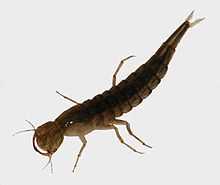Great diving beetle
| Dytiscus marginalis | |
|---|---|
 | |
| Bottom view | |
| Scientific classification | |
| Kingdom: | Animalia |
| Phylum: | Arthropoda |
| Class: | Insecta |
| Order: | Coleoptera |
| Family: | Dytiscidae |
| Genus: | Dytiscus |
| Species: | D. marginalis |
| Binomial name | |
| Dytiscus marginalis Linnaeus, 1758 | |



The great diving beetle, Dytiscus marginalis, is a large aquatic diving beetle native to Europe and northern Asia, and is particularly common in England. The great diving beetle, true to its name, is a rather sizable insect. The larvae can grow up to 60 millimetres (2.4 in) in length, while the adults are generally between 27–35 millimetres (1.1–1.4 in).
These beetles live in fresh water, either still or slow-running, and seem to prefer water with vegetation. They are dark-coloured (brown to black) on their back and wing cases (elytra) and yellow on their abdomen and legs. The male's wing cases are shiny, while those of the female are finely grooved. A voracious predator, this beetle hunts a wide variety of prey including small fish. The first two pairs of legs of the male are equipped with numerous suction cups, enabling them to obtain a secure grip while mating, and on their prey. [1][2]
They are able fliers, and fly usually at night. They use the reflection of moonlight to locate new water sources. This location method can sometimes cause them to land on wet roads or other hard wet surfaces.
Before they dive, they collect air bubbles in their wing cases which goes through the spiracles. The jaws of a great diving beetle are strong compared to their body size.
References
| Wikispecies has information related to: Dytiscus marginalis |
| Wikimedia Commons has media related to Dytiscus marginalis. |